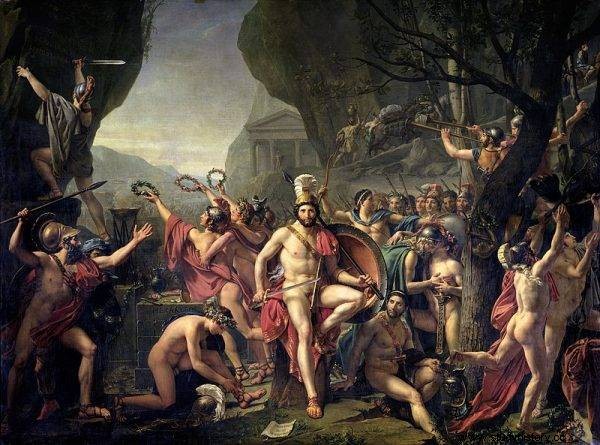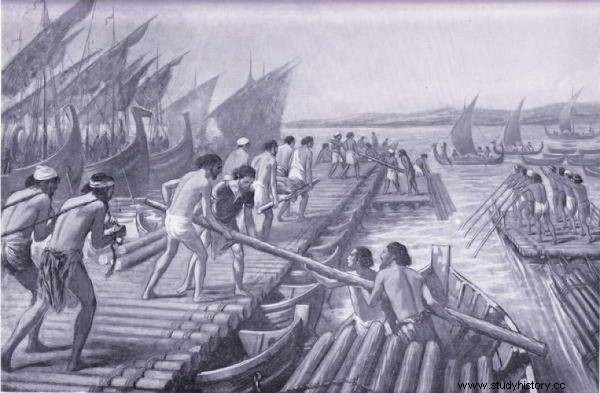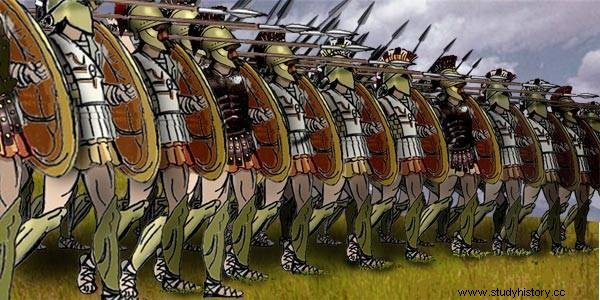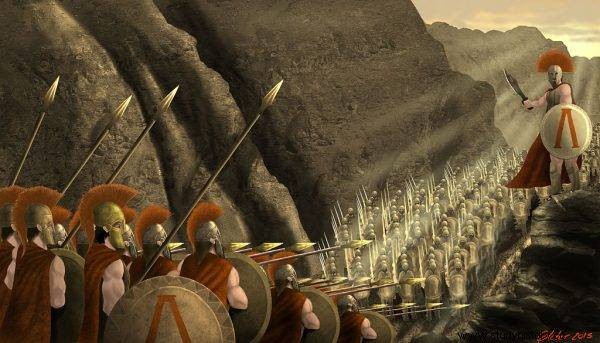The Battle of Thermopylae is one of the most famous battles of antiquity. 300 defenders stood up against the mighty Persian army. But are you sure 300?
The history of the world is full of distortions and understatements. Sometimes things considered facts have little to do with reality. On the other hand, events that seem too eerie to be true turn out to be the most real. In the "Truth or Myth" series we will try to debunk or confirm both these lesser and more serious historical myths. The story is not as obvious as it seems!
"And to you, O inhabitants of Sparta, who are rich in spacious squares, / Either a great city and very famous for Persian violence / It will fall into ruin, or if it does not fall, then from the Herakla / King family, when it falls, the country of Lacedaemon will be sorry" The ominous prophecy of the Pythia was supposed to sound. However, oblivious to the warnings of the Delphi seer, King Leonidas set off for Thermopylae with a handful of 300 of the most faithful warriors.

Leonidas at Thermopylae
This is what the legendary message says, additionally recorded in books, comics and movies. The best example is the already infamous picture 300 Zack Snyder. Meanwhile, even though the vision of the Spartan weapon's success was questionable in the face of the overwhelming superiority of Xerxes' troops , it was Leonidas' hoplites who weren't the only defenders of the Hot Gate.
Myriads of husbands
480 B.C.E. was to turn out to be peculiar in the history of Hellas. For the Persian king Xerxes organized against her one of the greatest invasions in the history of the ancient world . Seized by imperial ambitions and eager to retaliate for his father's defeat at the Marathon 10 years ago, he threw unimaginable forces against the wayward Greeks. According to Herodotus, his army was to count "in total two hundred and sixty-four men fit for battle, one thousand six hundred and ten" - which would correspond to the number over 2.6 million fighters . Well, the father of history continues:
If the combat strength was so great, then the number of the accompanying servants and those who were in the grain ships and in other ships accompanying the army - this figure was, I believe, not less than the number of men fit for battle. but more .
Shah's army was so powerful that on the road to Hellas many rivers would run out of water (!).
The reality is no less terrifying
Of course, the calculations of the Greek father of history should be taken with a pinch of salt. The people of antiquity loved the endless multiplication of hostile armies to emphasize the heroic attitude of their troops. Especially when their failure was written.

The Persians built the bridge over the Hellespont on nearly 700 ships
Such a huge crowd of people and, of course, animals would be an impossible logistical task - even in today's conditions. Nevertheless, the number of Xerxes' army estimated by modern historians at 120,000-300,000. armed (some even allow themselves to host 500,000 people) and so she must have made an electrifying impression on the witnesses. And when you add the bridge for this great army, which was thrown over the Hellespont on almost 700 ships, which was preceded by the gloomy fame of the royal "immortals" - the picture of the impending destruction of the Greek world seemed complete.
Hellas in need
In the face of such a power, the forces with which the people of philosophers decided to face the king of kings are all the more respectable. However, anyone who would see the 300 Spartans as the sole defenders of classical culture would be wrong. According to Herodotus, invaluable in this regard, whose estimation of Greek troops seems closer to the truth than the fantastic myriads of Persians, Leonidas had far more forces than the said 300 warriors. According to his account, under the orders of the king of Sparta it stood:
three hundred Spartan hoplites; a thousand Tegeates and Mantinis, half of each city; from Orchomenos in Arcadia, one hundred and twenty; from the rest of Arcadia a thousand. There were so many Arcadians. From Corinth four hundred, from Flejus two hundred, and from Mycenae eighty. These came from the Peloponnese; and of Boeotia, seven hundred from Tespia, and four hundred from Thebes. Apart from these, there were also established Opuntia Lokry with all their army and a thousand Phokians .
In total it was already over 5,000. armed (and some ancient historians even suggested 11,000 Hellenes fighting at Thermopylae). The calculations of the father of history are also probably inaccurate. It is otherwise known that Sparti - that is, full-fledged citizens of Sparta - were accompanied by several hundred Periods (citizens without political rights) and the hard to define number of Lacedaemonian slaves.
So where are the famous 300 against the world?
Three hundred or maybe…
Well, it turns out that this legendary number concerns only the third, last day of the struggle in the Thermopylae isthmus. Initially, the attacks of the Persian army, which had to pay huge losses, crashed against the Greek phalanx. Even when thrown into battle by Xerxes, the "immortals" had to acknowledge the superiority of the Hellenes. Their forces, skilfully maneuvering on a 15-meter-narrow and 1.5-kilometer long strip of land between the slopes of the Kallidromos Mountains and the cliff of the Aegean Sea, seemed to mock the Shahinshah's efforts.

With huge losses, the attacks of the Persian army crashed against the Greek phalanx
Unfortunately, the situation changed dramatically when it came to the betrayal of a certain Ephialtes , as legendary as the defense of the Hot Gates. . The Greek, who knew the area well, showed Xerxes the mountain path leading to the rear of Leonidas' troops . The king, seeing the hopeless plight of his forces and probably suspecting that "the allies were neither willing nor willing to share the dangers, ordered them to go away, saying that it was not right for him to leave." Some scholars of the subject suggest that Herodotus' tale of dismissing most of his allies was supposed to cover up the fact that those, seeing what was going on, simply escaped.
After all, Leonidas remained at the post along with a selected unit of 300 Spartiats and ... probably 1 thousand more. allied forces.
Silent heroes
It turns out that the king of Sparta was not only brave and skilled in the art of war, but also intelligent. He was well aware that the position on the isthmus was lost. But he probably also knew that too thin (even madly brave) forces left in the Hot Gates would not hold back the Persian pressure for a long time, who could threaten the retreating Allied forces. Therefore kept with him some Thebans who, as Herodotus writes, "stayed involuntarily and reluctantly" and the hoplites of Tespia. However, it quickly became apparent how much it was worth forcing the forced abandonment of the Theban warriors, who laid down their arms and surrendered to Xerxes as soon as there was a general assault by the Persians.

Leonidas remained at the post along with a selected unit of 300 Sparti and ... probably 1 thousand more. allied forces.
Against the background of their betrayal , the attitude of the Tespians is rising to the level of true heroism . For these remained, according to the father of history:“with the greatest desire, because they said that they would not leave Leonidas and his men and would not depart; how they persevered on the spot and fell together ”. Therefore, who knows if they deserve more glory than the Spartans. Leonidas and his Lacedaemonians did not depart, because their law and upbringing did not allow them to do so . On the other hand, the brave inhabitants of Tespia had a free choice, and yet they did not abandon an ally.
Is it not then that the famous inscription in honor of the fallen in Thermopylae should not begin with the words:"Guest, tell the Tespians that they have fallen in battle ..."?
300 Spartans detained the Persians at Thermopylae. Myth
Bibliography
- Hammond N.G.L., History of Greece , crowd. A. Świderkówna, Warsaw 1994.
- Herodotus, Happening , crowd. S. Hammer, Wrocław 2005.
- Kębiek K., False myth of Thermopylae , weeknikprzeglad.pl [access:17/03/2022].
- Olędzki M., Waszak D., Thermopylae three times , [in:] Faces of war , ed. T. Grabarczyk, M. Pagońska-Pol, vol. 2: The army of the nature account , Łódź 2020.
